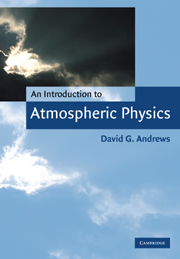Book contents
- Frontmatter
- Contents
- Preface
- 1 Introduction
- 2 Atmospheric thermodynamics
- 3 Atmospheric radiation
- 4 Basic fluid dynamics
- 5 Further atmospheric fluid dynamics
- 6 Stratospheric chemistry
- 7 Atmospheric remote sounding
- 8 Atmospheric modelling
- Appendix A Useful physical constants
- Appendix B Derivation of the equations of motion in spherical coordinates
- Appendix C Solutions and hints for selected problems
- Bibliography
- Index
7 - Atmospheric remote sounding
- Frontmatter
- Contents
- Preface
- 1 Introduction
- 2 Atmospheric thermodynamics
- 3 Atmospheric radiation
- 4 Basic fluid dynamics
- 5 Further atmospheric fluid dynamics
- 6 Stratospheric chemistry
- 7 Atmospheric remote sounding
- 8 Atmospheric modelling
- Appendix A Useful physical constants
- Appendix B Derivation of the equations of motion in spherical coordinates
- Appendix C Solutions and hints for selected problems
- Bibliography
- Index
Summary
In this chapter we consider a small selection of techniques for observing the atmosphere. These techniques have been chosen for two main reasons: (a) they illustrate the use of physical principles, including principles introduced earlier in this book; and (b) they provide crucial data on atmospheric phenomena modelled elsewhere in this book, such as Rossby waves, gravity waves and the Antarctic ozone hole. The topics considered are all examples of remote sounding; we do not attempt to present a balanced account of all observational methods.
In Section 7.1 we briefly list some of the main atmospheric observational methods. In Section 7.2 we outline the principles of remote sounding of the atmosphere from space, focusing on methods that rely on thermal emission from atmospheric gases and on scattering of solar radiation by atmospheric gases. Then in Section 7.3 we discuss three types of ground-based remote sounding, namely the Dobson spectrophotometer, radars and lidars. We omit the details of the instruments' optical and electronic systems, the technicalities of signal processing and the sophisticated statistical methods that may be required in order to extract meaningful physical quantities from the raw measurements.
Atmospheric observations
Quantitative observations of the atmosphere are made in many different ways. Routine meteorological measurements of ground-level temperature and wind are made with simple thermometers and anemometers, respectively, and routine measurements of temperature and humidity through the depth of the troposphere are made with balloon-borne instruments (radiosondes) that transmit information back to the surface by radio.
- Type
- Chapter
- Information
- An Introduction to Atmospheric Physics , pp. 177 - 202Publisher: Cambridge University PressPrint publication year: 2000
- 1
- Cited by



